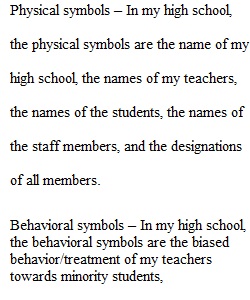


Q Participation in this learning activity is worth 2.5% of your final grade. For this activity, you will explore how your organization’s culture may be influencing the workplace* communication problem that you are investigating. You may be able to use the ideas you develop here in your final project. Before you tackle this exercise, please make sure you have read the Week 5 course materials. (*Remember, if you are not employed or cannot discuss your workplace, you should be using a communication problem from another organizational setting in which you are involved for your final project, such as school, church, or a community group.) Objective: This question is designed to help you contextualize your final project. You may be able to use material you develop here in your final project. Background: Please begin this exercise by reading the following information carefully. Organizational Culture Theory is based on a metaphor— a creative device to make meaning by comparing two disparate ideas or things. This theory relies on a field of study known as ethnography, which uses qualitative methodologies of investigation. Ethnography involves observations of customs and culture. The researcher becomes part of the organization to systematically observe, analyze, and interpret artifacts, stories, rituals, and practices in order to gain insight into its culture. An ethnographer of communication examines how communication is used to build the shared beliefs and value systems that sustain a specific social structure (Baillet, 2009). Ethnographic study of organizations shows members act out something researchers call communicative performances, a metaphor suggesting organizational life is like the theater (Tracy, 2009). Members of an organization bond through specific types of “performances” that help them create and maintain a shared sense of reality. Different organizations have different organizational realities. Because of this, the actions performed by the members of an organization are interpreted differently depending on the organization. Activity: To get a sense of the role organizational culture may be playing in the communication problem you are investigating for your final project, review the definitions of the following terms in our course materials and then describe an example of as many of them as you can from your workplace:* • Physical symbols • Behavioral symbols • Verbal symbols and • Ritual performances • Passion performances • Social performances • Political performances • Enculturation performances Complete your response by analyzing and explaining how your workplace’s culture affects your organization’s communication processes or information flows. Could that culture be contributing to the communication problem you are investigating? Make sure to connect your ideas to the course content that you were asked to read by using American Psychological Association-style references. If you are unfamiliar with that reference style, you can find examples at the following link: http://sites.umgc.edu/library/libhow/apa_examples.cfm . Due Dates: Please post your initial response to this prompt by 11:59 p.m. Eastern Time on <Saturday>. You will not see any of your classmates’ posts until you post your own. Once you have replied, please help your classmates here to develop their ideas by sharing your knowledge, expertise, and resources on their topics. Post at least two substantive comments on your classmates’ exercises by 11:59 p.m. Eastern Time on Tuesday. You also will be working on Discussion 5.2 this week. References Bailett, P. O. C. Ethnography of communication. In S. W. Littlejohn and K. A. Foss (Eds.), Encyclopedia of communication theory (Vol. 1, pp. 356-360). Thousand Oaks, CA: SAGE. Tracy, S. J. (2009). Organizational culture. In S. W. Littlejohn and K. A. Foss (Eds.), Encyclopedia of communication theory (Vol. 1, pp. 714-7166). Thousand Oaks, CA: SAGE. ©2020 University of Maryland Global Campus
View Related Questions